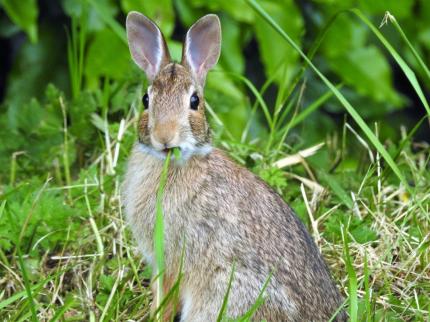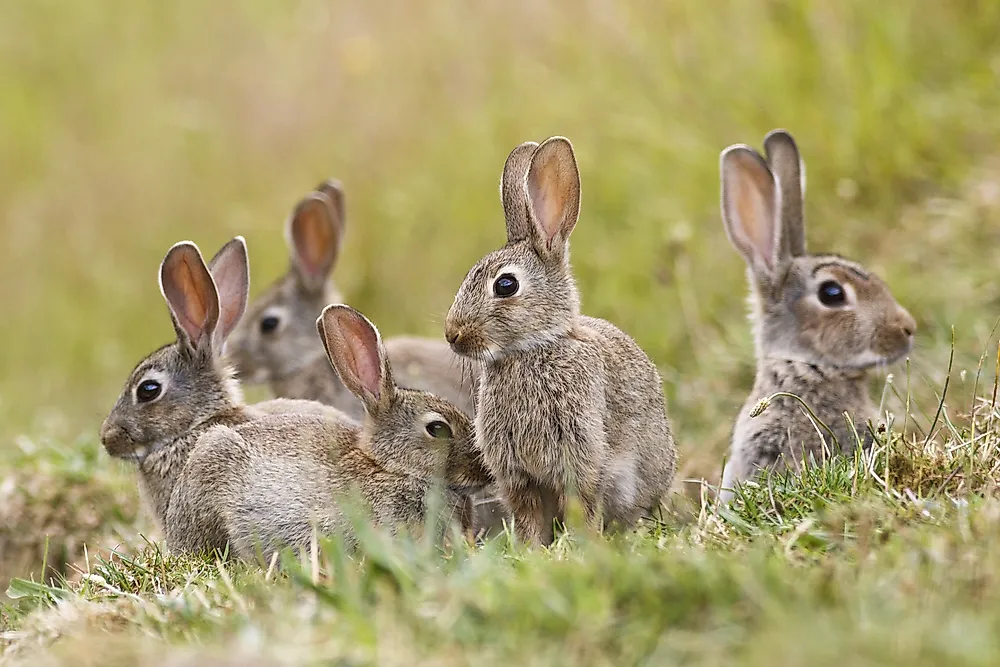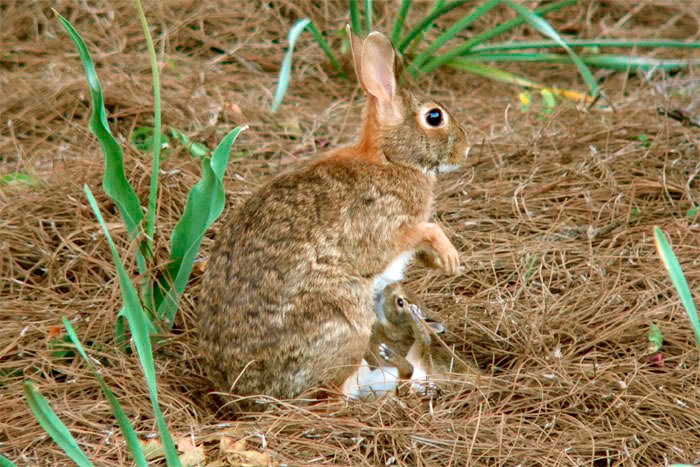Cottontail rabbits play important roles in their ecosystems. The bands versatility allows it to accommodate many settings from quiet acoustic duo to jazz quintet to full dance band with horns and guitar.
 Living With Wildlife Rabbits Washington Department Of Fish Wildlife
Living With Wildlife Rabbits Washington Department Of Fish Wildlife
It may use the dens of groundhogs as a temporary home or during heavy snow.

Do cottontails live in groups. Diet Cottontail rabbits eat a great variety of plant materials. In the Eastern areas of America Canada Arizona and Mexico. Rabbits can live in meadows woods forests grasslands deserts and wetlands.
Eastern cottontails are crepuscular to nocturnal feeders. There is a wide variety of rabbits found in Eastern Cottontail rabbits. Diet and feeding.
There are also significant differences in the two groups burrowing habits only rabbits make underground burrows and in the characteristics of their young rabbits have naked newborns hares have furred newborns. In the summer green plants are favored. The average Massachusetts cottontail spends its entire life in an area of less than 15 acres although in the winter it may move a mile or so from its summer feeding area in order to obtain better cover or a new food supply.
The eastern cottontail rabbit doesnt dig its own burrows like some other rabbit species do so they will either find an empty burrow from another animal to crawl into or they will look for woody vegetation to huddle under during cold weather. Desert cottontail rabbits tend to live alone and avoid interacting with one another. The Eastern cottontail does not dig their own holes but they can re-use the.
A female will however create a nest by digging a hole in the ground before giving birth. In the laboratory Kovach and her students and colleagues identify DNA from fecal pellets droppings collected by field biologists to determine whether the pellets were deposited by New England cottontails eastern cottontails a non-native species that now exists in greater numbers regionwide. In general however a single cottontail rabbit occupies a territory of about 3 hectares 8 acres.
The desert cottontail mainly eats forbs and grass which constitutes 80 of its diet. They do not create their own burrows but will take shelter in burrows made by other animals. Determine how to best conduct fecal pellet sampling to learn where New England cottontails live.
Cottontails are found in dryland arid areas wood grasslands. The gestation period of cottontails lasts 26 days and in. The cottontail bunny is a midsize rabbit and a herbivore and female cottontails average three to four litters per year.
Some have brown color some have grey and some are reddish brown in color. Their size ranges from being 8 inches long and weighing less than a pound to being 20 inches long and more than 5 pounds. The cottontail rabbits usually like to live on the edges of fields and meadows where there are plenty of herbs and grasses and also brushwood covered with.
The female alone is responsible for raising the kits to adulthood. Cottontail rabbits live above ground in nests and usually do not live in groups. Their range is from eastern Montana to west Texas and into northern and Central Mexico.
Eastern Cottontails do not hibernatethey are active year-round. The male generally lives alone his entire life and only seeks out companionship when a nearby female is in heat. Desert cottontails do not live in social burrow systems but will show a high level of tolerance towards other individuals within their home range.
Desert Cottontails mainly feed on a variety of grasses but they will also eat fruit vegetables and nuts. As far as hares and cottontails are concerned male and female rabbits do not live together in the wild. The cottontail rabbits are most common species that can be found all over the Eastern-to mid- Western USA from Canada to South America.
In suburban areas they will also look for covered areas. Mating season lasts from January to the. How do rabbits stay warm in the winter.
Do Male And Female Rabbits Live Together In the Wild. THE COTTONTAILS are one of San Franciscos most exciting musical groups playing a wide range of styles ranging from 2030s Gatsby-era jazz classic 40s swing and vintage 50s60s RB. Cottontails likes to live in bushy areas where their presence is not easily detected by predators.
Although they usually spend most of the daylight hours resting in. Eastern cottontail rabbits reside throughout the eastern United States and parts of Canada and Mexico. About half of the food consumed are grasses including bluegrass and wild rye but wild.
Males rarely tolerate another male near them but females are sometimes seen gathering in an area with plenty of food without coming into conflict. It also eats many other plants even including cacti. Cottontails do not dig burrows but rather rest in a form a shallow scratched-out depression in a clump of grass or under brush.
Here at zoological world you can see different animals whose knowledge are being shared with you guys. Where do Cottontail Rabbits Live. Cottontails when becoming eighty days old starts to breed.
Most rabbits live in a 5-acre area their entire lives. When not feeding individuals live in heavy brush brambles or holes in order to hide from their many predators. She will line the nest with fur and grass.
This allows them to be so fast in escaping from predators. Eastern Cottontail Rabbits are common from coastal to mountain regions and are the most hunted animal in the eastern United States.
 Eastern Cottontail Rabbit National Geographic
Eastern Cottontail Rabbit National Geographic
Eastern cottontails are crepuscular meaning they are most active around dusk and dawn.

Do eastern cottontails live in groups. They are named cotton tail because of its tail which is covered in cotton. Where do Cottontail Rabbits Live. These rabbits can produce 3-4 litters of around 5 kits each year beginning in early spring.
Cottontails are herbivores that eat grasses clovers and dandelions in summer and bark buds and twigs in winter. Social system - The eastern cottontail is solitary except when mating or raising young. Eastern cottontails are solitary and very territorial animals.
Adult cottontails occupy home ranges which may. Eastern cottontails do not dig burrows but rather rest in a form a shallow scratched-out depression in a clump of grass or under brush. An important habitat feature within each of these cover types includes rock.
Eastern cottontails are habitat generalists and can survive in many different environments or cover types. We can call them ubiquitous animals which means they are everywhere. Old fields grasslands shrublands and swamps can all be home to a resourceful rabbit.
Due to their often large populations in Eastern. Eastern Cottontail Rabbits have powerful hind legs which are longer than their front legs and their hind feet are also very long. Eastern cottontail rabbits reside throughout the eastern United States and parts of Canada and Mexico.
Left untreated 999 death rate Euthanize if large patches of fur missing or badly injured Place bunny in box over heating pad set on HIGH keep this setting for 2-3 days Clean scratches punctures missing hair. From South America to Canada in US Green Plains and in East Cost. Most common type of rabbits that are found everywhere are eastern cotton tail.
They often remain in one spot unmoving for long periods of time. This extremely high potential rate of reproduction can cause rabbit populations to greatly increase in numbers over very short periods of time. They are also coprophagous which means they eat their own droppings.
The cottontail bunny is a midsize rabbit and a herbivore and female cottontails average three to four litters per year. Further summary of diseases and pests is available. The average life span of an eastern cottontail in the wild is usually less than three years.
They are active year-round and typically live in one home range throughout their lifetime. Cottontails can reproduce by one year of age and a reproductively mature doe can have up to five litters of three to eight young in a single season. Eastern cottontails are hosts to fleas ticks lice cestodes nematodes trematodes gray flesh fly larvae botfly larvae tularemia shopes fibroma torticollis and cutaneous streptothricosis.
The Eastern cottontail does not dig their own holes but they can re-use the. Outdoor Cage A common dilemma for first-time rabbit carers is where to put the cage in. Eastern Cottontail.
Mostly found in brown and grey color. Adults may form social hierarchies an outcome of aggressive encounters involving chasing and submission rarely fighting. They prefer an area where they can hide quickly but be out in the open.
They love living in groups so you may want to consider this if you are planning to take care of a big group of Eastern Cottontails. Eastern cottontails Sylvilagus floridanus vary from gray to brown and have large ears and hind feet and short white tails. They are distributed throughout almost every climate and in other parts of the United.
The cottontail rabbits are most common species that can be found all over the Eastern-to mid- Western USA from Canada to South America. When fleeing predators they run in a zigzag pattern and can jump sideways to disrupt their scent trail. The cottontail rabbits usually like to live on the edges of fields and meadows where there are plenty of herbs and grasses and also brushwood covered with.
The eastern cottontail has to contend with many predators both natural and introduced. They may use the dens of groundhogs as a temporary home or during heavy snow. Consider these pros and cons.
Males do not participate in raising their young. They live in residential lawns and other grassy areas near woods or shrubs that provide cover. Dominant males do most of the breeding but they do not maintain pair bonds nor aid in the care of the young.
Rabbits that live indoors have longer lives and are more social and happy. They are common sights in farm fields orchards hedgerows and backyards but they survive in remote woodland areas too. In captivity though a cottontail rabbit can live up to eight years.
Cottontail rabbits play important roles in their ecosystems. Intake Procedure Eastern Cottontails Cat Scratches and Bites. A wild population of eastern.